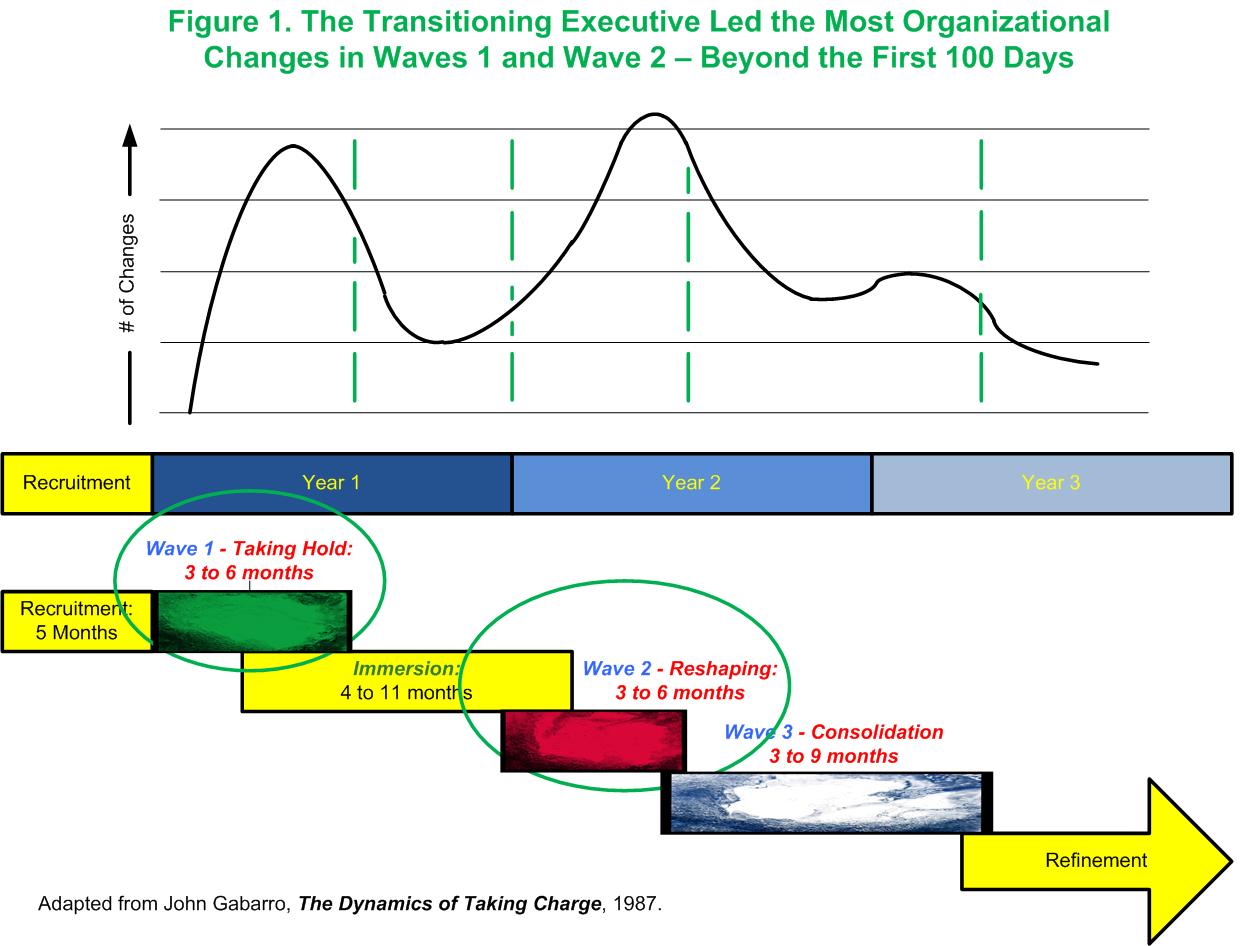Three Waves of Change® Services

For a Senior Executive Taking Charge in a New Role,
It's About the Changes Beyond the First 90 - 100 Days:
Managing the Three Waves of Change During the Transition
The Need
Defining the Need for more Comprehensive Senior Executive Onboarding and Transition Management Processes
Before we present our pitch for the need for more comprehensive senior executive transition services, let's begin by drawing from your experience, insights, and wisdom.

From your experience, what are your best answers to the following questions concerning a senior executive being promoted into a new role or being recruited into a new role from the outside?
- How long does it take for a new executive to have a deep, accurate, and valid understanding of the essential elements and dynamics of "what they have gotten themselves into?"
- How long does it take a new senior executive to develop a defensible point of view of what they should focus on to create the greatest value for the business given the situation, the time, and the likely resources they may have?
- How long does it take for the senior executive to develop enough confidence in his or her assessment of the situation that he or she is willing to take a stand on what needs to be done to improve the business' performance?
- On the first anniversary of the new executive's job, how many wish they knew at 90 to 100 days what they know now?
- How often does an executive's role evolve and change significantly over the course of 1 to 3 years?
- How long does it take even a successful executive to build sufficient credibility, trust, cooperation, and influence horizontally with peers and other senior stakeholders in order to successfully fulfill the expectations for his or her contributions?
- For "high potential" executives being groomed for further advancement, how long does it take for them to live with the consequences of their decisions and how do we know what they learned from that assignment?
The Research Identifying the Need
Note: The rough benchmark of 40+% failure for executives new to their role failing to meet their objectives in the first 18 to 24 months and the multiple sources supporting that benchmark are described on the Wiznami home page.
A Predictable Process of Executive Learning in the New Role: The "Three Wave Phenomena"

John Gabarro of the Harvard Business School discovered that almost all senior executives, upon entering a new role, experience an iterative process of progressive learning which he described as "the three wave phenomena" (shown in Figure 1). Rather than a nice, neat, linear progression of entering the new role by first diagnosing the presenting business problems, creating an action plan, and thenimplementing the action plan to solve the presenting business problems in short order, what Gabarro discovered in his 3 year longitudinal study of more than 30 executives¹ was that the typical executive actually experienced cycles of learning that resulted in three waves of change. The learning was iterative. There were no short cuts. It did not matter if the new executive was an outside hire or promoted from within. It also did not matter if the situation required a turnaround or not. While each situation had its own unique twists and nuances, the overall model of the executive needing to manage three waves of change was a consistent finding. At this level of management, the essential patterns of executive transitions are a predictable executive learning process far beyond the first 90 to 100 days.
The "Three Wave Phenomena" occurs because the Wave 1 changes (first 3 to 6 months) are often incomplete solutions to the presenting problems, the changes reveal other previously hidden problems, and the changes unintentionally create new problems. The "Immersion" stage that follows allows the executive and his or her teams, in collaboration with other stakeholders, to diagnose the new and existing underlying root causes of the barriers to solving the problems and improving the business' performance. With most of the diagnoses complete (some level of diagnosis and monitoring is, however, continuous), plans are made to shape the necessary organizational capabilities that will drive improved performance.
Wave 2 typically has the largest number of implemented changes (Wave 1 typically has slightly fewer changes than Wave 2) and requires the effective management of change that will often stretch across departmental and other organizational boundaries. Creating sustainable change also ultimately requires enabling the ownership of the targeted changes by local stakeholders deep in the organizational structure who will ultimately be affected by the changes.. Wave 2 requires a specific set of effective change management skills to successfully implement a critical mass of the changes. That skill set is briefly described later in this article.
Wave 3, Consolidation, includes the smallest number of changes of the three waves. Wave 3 includes continued roll out of the changes of Waves 1 and 2 to the rest of the organization and the associated multiple alignment actions of incentives, monitoring processes, metrics, and accountabilities. Wave 3 changes are intended to institutionalize the primary set of changes from Waves 1 and 2.
The Refinement stage is essentially a smaller set of efforts focused on continuous improvement of the institutionalized processes.
Related Links:
Three Waves of Change® (Current Page)
A Sample of Organizational Diagnostic Tools (Typically during the Immersion Stage)
Footnote:
1. John J. Gabarro. The Dynamics of Taking Charge. Boston: Harvard Business School Press, 1987, p. 7.
###
Wiznami Corp. is an a senior executive coaching service based in Naples, Florida.

